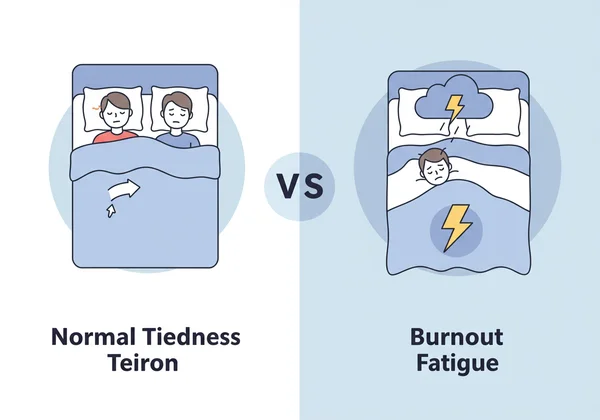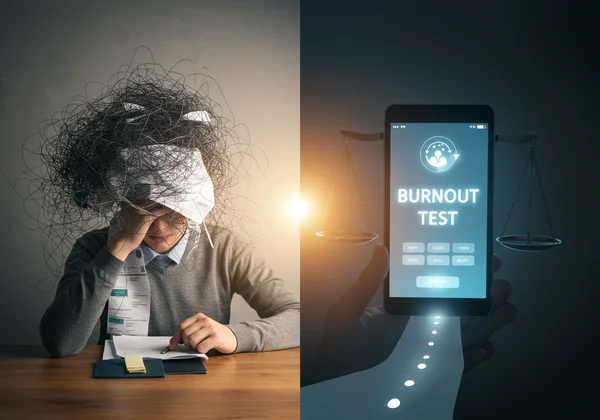What Burnout Fatigue Really Feels Feels Like: A Burnout Test Guide to Symptoms Beyond Tiredness
Feeling constantly drained, even after what seems like enough rest? You're not alone, and that profound exhaustion is likely more than just ordinary fatigue. This article delves into the insidious experience of burnout fatigue, helping you understand its unique characteristics. What does burnout fatigue feel like? It’s a state of chronic exhaustion that seeps into every corner of your life, making you question if you're just tired or something more is at play. Understanding this feeling is the first step toward regaining control, and a confidential online burnout assessment can provide the clarity you need.
Is It Burnout Fatigue, or Just Normal Tiredness?
One of the most common internal debates for a stressed professional is distinguishing deep-seated burnout from simple tiredness. While both can leave you feeling drained, their roots and resolutions are worlds apart. Normal tiredness is typically acute; it’s a direct result of exertion and is remedied by rest, a good night's sleep, or a relaxing weekend. Burnout fatigue, however, is a different beast entirely. It’s a chronic condition that lingers regardless of how much you sleep.

The Persistent & Pervasive Nature of Burnout Exhaustion
The hallmark of burnout fatigue is its persistent exhaustion. It’s the feeling of waking up just as tired as when you went to bed, a bone-deep weariness that a full night’s sleep cannot touch. This isn't just about feeling sleepy; it’s an emotional, mental, and physical depletion that follows you throughout the day. This pervasive exhaustion makes even small tasks feel monumental and drains the color from activities you once enjoyed. It’s a low-battery warning that never goes away, signaling that your internal resources are critically low.
Why It's More Than Just Lacking Motivation or Feeling Lazy
Many people experiencing burnout wrongly accuse themselves of being lazy or having a lack of motivation. This self-blame is a symptom of burnout itself. Laziness is an unwillingness to act, whereas burnout fatigue is an inability to do so. Your mind may want to engage, but your body and emotions simply can’t muster the energy. It’s a state of being "used up," where the well of your resilience has run dry due to prolonged, unmanaged stress. Acknowledging that this is a valid physiological and psychological response, not a character flaw, is a crucial step.
Key Physical and Emotional Symptoms of Burnout Fatigue
Burnout fatigue isn't just a feeling; it manifests in tangible ways that affect your entire being. Understanding these symptoms can help you connect the dots between your chronic stress and how you feel daily. Recognizing these signs is the first step, and a burnout symptoms test can help you quantify where you stand. It’s about listening to what your body and mind are desperately trying to tell you.
When Your Body Feels Like It's Shutting Down from Stress
Prolonged stress takes a severe physical toll, leading to a sensation that your body is shutting down from stress. This can manifest in several ways. You might experience frequent headaches, muscle pain, or digestive issues that have no other clear medical cause. Your immune system may weaken, leading to more frequent colds and illnesses. For many, it feels like a constant state of "fight or flight" has finally exhausted the system, leaving behind a profound physical weariness and vulnerability.
The Mental Fog and Emotional Numbness that Accompany Exhaustion
Beyond the physical toll, burnout fatigue creates significant cognitive and emotional disruption. Mental fog is a common complaint, making it difficult to concentrate, remember details, or make decisions. You might find yourself rereading the same email multiple times or struggling to organize your thoughts. Alongside this cognitive impairment comes emotional numbness. You may feel cynical, detached from your work, and disconnected from colleagues and loved ones. The passion you once had is replaced by a sense of dread or indifference, a protective mechanism your mind employs to shield itself from further depletion. If these signs resonate, it may be time to self-assess burnout more formally.

Everyday Realities: Experiencing Burnout Fatigue in Your Life
The symptoms of burnout fatigue don't exist in a vacuum; they actively disrupt your daily life, affecting your performance at work and your happiness at home. Seeing how this exhaustion plays out in real-world scenarios can help validate your experience and highlight the urgency of addressing it. Your professional life and personal well-being are deeply intertwined, and burnout creates fractures in both.
The Impact on Work Performance and Productivity
In your professional life, burnout fatigue can be devastating. The mental fog and lack of energy directly lead to decreased productivity and a higher rate of errors. You might miss deadlines, struggle to innovate, or find it impossible to contribute to team meetings with your usual enthusiasm. This decline in performance can create a vicious cycle: poor results lead to more stress and self-doubt, which in turn deepens the burnout. This is why getting a clear picture of your risk level with a free burnout test can be so empowering.
How Burnout Affects Relationships and Personal Hobbies
Burnout fatigue inevitably spills over into your personal life, robbing you of the energy needed for personal well-being. After a draining workday, you may have nothing left to give to your family or friends, leading to irritability and social withdrawal. Hobbies and activities that once brought you joy and relaxation now feel like chores. This erosion of your personal life is a critical red flag, indicating that the issue is not just "work stress" but a comprehensive state of burnout that requires immediate attention and a dedicated recovery plan.

Recognizing Burnout Fatigue: Your Vital First Step to Recovery
Understanding that what you are feeling is burnout fatigue—a serious response to chronic workplace stress—is the most important step you can take. It’s not laziness, a lack of willpower, or something you can simply "push through." It is a signal that your mind and body need a change. By acknowledging these symptoms, you shift from a place of self-blame to one of empowerment.
The journey to recovery begins with assessment. You need a clear, objective understanding of your current state. Our science-backed Burnout Test, based on the established Maslach Burnout Inventory (MBI) principles, is designed to give you just that. It provides a confidential, immediate summary of your risk level and offers the option for a deeper, AI-driven report with actionable insights. Don't stay in the dark. Take our free Burnout Test today and take the first concrete step toward managing your stress and reclaiming your energy.
Frequently Asked Questions About Burnout and Fatigue
What are the main differences between extreme tiredness and burnout fatigue?
Extreme tiredness is usually linked to a specific cause (e.g., a long flight, intense workout) and is resolved with rest. Burnout fatigue is a chronic state of emotional, physical, and mental exhaustion caused by prolonged stress. It persists even after rest and is often accompanied by cynicism and a sense of ineffectiveness.
Can burnout truly make your body feel like it's physically shutting down?
Yes, absolutely. Chronic stress dysregulates your nervous system and hormonal balance (like cortisol levels), leading to physical symptoms like persistent fatigue, headaches, weakened immunity, and muscle pain. This collection of symptoms can feel like your body's core systems are struggling to function, a sensation often described as "shutting down."
How can I distinguish if I'm experiencing burnout or just a period of low motivation?
Low motivation can be temporary and context-specific. Burnout is more pervasive. Ask yourself: Is this feeling accompanied by deep exhaustion and cynicism? Does it extend beyond work into your personal life? Have you lost interest in things you once loved? If so, it's more likely burnout. A structured workplace stress test can help you differentiate.
What is the very first step one should take after recognizing burnout fatigue?
The first and most critical step is to get a clear assessment of your situation. Acknowledging the problem is key, but understanding its severity across different dimensions (exhaustion, cynicism, professional efficacy) gives you a solid foundation for action. Taking a confidential and science-backed test helps create a targeted recovery plan.